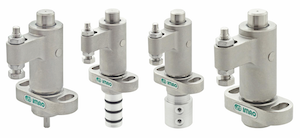Pneumatic swing clamps for stronger workholding force
Fixtureworks has bolstered its array of clamps, modular fixturing and set-up accessories by offering convenient, yet powerful compact pneumatic swing clamp series. Air assisted pneumatic clamps offer more efficiency and automation in production and are automated machining clamps with unique clamping mechanism.
 The main feature of these clamps is that they are compact and provide high clamping force with a small body. Simultaneous controls or remote operations are possible with pneumatic swing clamps. The compact design allows for multiple parts clamping in limited space.. The combination of mechanical and pneumatic clamping technology generates a fivefold higher clamping force than pneumatic cylinders of the same size.
The main feature of these clamps is that they are compact and provide high clamping force with a small body. Simultaneous controls or remote operations are possible with pneumatic swing clamps. The compact design allows for multiple parts clamping in limited space.. The combination of mechanical and pneumatic clamping technology generates a fivefold higher clamping force than pneumatic cylinders of the same size.
The pneumatic swing clamps provide arm length in different styles ranging from 30 to 55 mm and move in a 90° arc, while their wedge-style locking provides high holding capacity. The pneumatic feature allows for greater efficiency by automation, which can help improve productivity. These clamp configurations offer a versatile choice for a variety of fixturing and workholding applications and are especially useful for highly repetitive clamping jobs.
The range of Fixtureworks swing clamps consists of four configurations: AMWSW-W nickel plated compact pneumatic swing clamp; AMWSW-W-AC nickel-plated steel with threaded ports that detect clamping/unclamping; AMWSW-W-AG nickel plated steel with gasket-style de-tecting ports; and AMWSW-W-D nickel plate with a rod on the bottom that can detect clamp-ing/unclamping with switches. The wedge piston mechanism of the swing clamp provides up to 0.65 kN high clamping force. The clamping height of the arm is up to 51 mm for a finished surface and 53.5 mm on a rough surface.
Another advantage of Fixtureworks pneumatic swing clamp is the ease of set up. A clear-ance between clamping spindle and workpiece should be roughly half of the clamping stroke, which allows the clamp’s arm to swing horizontally and create proper clearance.
To ensure proper usage, the user must first apply air to the unclamping port to move the clamp to unclamping position. Then rotate the arm manually to straight direction and create an ap-propriate clearance to the workpiece. Putting a feeler gauge between the workpiece and the clamping spindle facilitates this setting. Finally, they must affix the clamping spindle with nuts.












